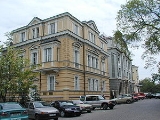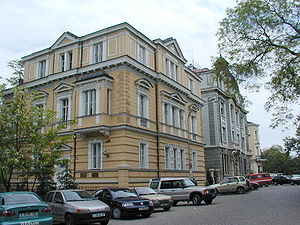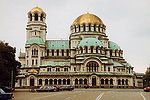
Oborishte, Sofia
Encyclopedia
Oborishte is an urban district located in the centre of the Bulgaria
n capital Sofia
. the population is 36,000.
 It has an area of 3,07 hectares, of which streets and squares encompass 59 ha, parks and gardens 47 ha, schools and kindergartens 9 ha, hospitals and polyclinics 5 ha, embassies 1.5 ha, theatres 1 ha, petrol stations and parkings 2.5 ha, churches 1 ha, administrative buildings 16 ha and residential areas 164 ha.
It has an area of 3,07 hectares, of which streets and squares encompass 59 ha, parks and gardens 47 ha, schools and kindergartens 9 ha, hospitals and polyclinics 5 ha, embassies 1.5 ha, theatres 1 ha, petrol stations and parkings 2.5 ha, churches 1 ha, administrative buildings 16 ha and residential areas 164 ha.
A large part of the population is engaged in government and administration. There are several ministries and other important institutions including the Council of Ministers, the Ministry of Regional and Public Development, the Ministry of Education, the Social Ministry, the Energetics Committee, the Capital Municipality, the Parliament building, the State Archive Bureau and many embassies and others.
Three institutions for higher education are located in the district: the National Academy of Arts
, the State Academy of Music and the Military Academy Georgi Sava Rakovski. There are 12 schools, 6 kindergartens and 3 chitalishta
.


 The municipal area occupies the eastern part of the City centre including some parts of ancient Serdica. Many cultural institutions and monuments of national importance are located in Oborishte including 15 monuments (Monument to Vasil Levski
The municipal area occupies the eastern part of the City centre including some parts of ancient Serdica. Many cultural institutions and monuments of national importance are located in Oborishte including 15 monuments (Monument to Vasil Levski
, Monument to the Unknown Soldier
, Monuments to SS Cyril and Methodius, Doctors, Aleksandar Stamboliyski
, Ivan Vazov
and others), 40 memorial plates, 211 Monuments of Culture and 9 churches.
Cultural Institutions:
Churches include:
The Holy Synod
and the Apostolic Nunciature
are also located here.
Bulgaria
Bulgaria , officially the Republic of Bulgaria , is a parliamentary democracy within a unitary constitutional republic in Southeast Europe. The country borders Romania to the north, Serbia and Macedonia to the west, Greece and Turkey to the south, as well as the Black Sea to the east...
n capital Sofia
Sofia
Sofia is the capital and largest city of Bulgaria and the 12th largest city in the European Union with a population of 1.27 million people. It is located in western Bulgaria, at the foot of Mount Vitosha and approximately at the centre of the Balkan Peninsula.Prehistoric settlements were excavated...
. the population is 36,000.

A large part of the population is engaged in government and administration. There are several ministries and other important institutions including the Council of Ministers, the Ministry of Regional and Public Development, the Ministry of Education, the Social Ministry, the Energetics Committee, the Capital Municipality, the Parliament building, the State Archive Bureau and many embassies and others.
Three institutions for higher education are located in the district: the National Academy of Arts
National Academy of Arts
The National Academy of Arts is an institution of higher education in Sofia, the capital of Bulgaria. It is the oldest and most renowned academy of arts in the country....
, the State Academy of Music and the Military Academy Georgi Sava Rakovski. There are 12 schools, 6 kindergartens and 3 chitalishta
Chitalishte
A chitalishte is a typical Bulgarian public institution and building which fulfils several functions at once, such as a community centre, library and a theatre. It is also used as an educational institution, where people of all ages can enroll in foreign language, dance, music and other courses....
.
Culture



Monument to Vasil Levski, Sofia
The Monument to Vasil Levski in the centre of Sofia, the capital of Bulgaria, is one of the first monuments to be built in the then newly-liberated Principality of Bulgaria...
, Monument to the Unknown Soldier
Monument to the Unknown Soldier, Sofia
The Monument to the Unknown Soldier is a monument in the centre of Sofia, the capital of Bulgaria, located just next to the 6th-century Church of St Sophia, on 2 Paris Street. The monument commemorates the hundreds of thousands of Bulgarian soldiers who died in wars defending their homeland...
, Monuments to SS Cyril and Methodius, Doctors, Aleksandar Stamboliyski
Aleksandar Stamboliyski
Aleksandar Stamboliyski was the prime minister of Bulgaria from 1919 until 1923. Stamboliyski was a member of the Agrarian Union, an agrarian peasant movement which was not allied to the monarchy, and edited their newspaper...
, Ivan Vazov
Ivan Vazov
Ivan Minchov Vazov was a Bulgarian poet, novelist and playwright, often referred to as "the Patriarch of Bulgarian literature". He was born in Sopot, a town in the Rose Valley of Bulgaria ....
and others), 40 memorial plates, 211 Monuments of Culture and 9 churches.
Cultural Institutions:
- National Opera and BalletNational Opera and BalletThe National Opera and Ballet is a national cultural institution in Bulgaria that covers opera and ballet. It is based in an imposing building in Sofia, the capital of Bulgaria....
- State Musical Theatre "St. Makedonski"
- Dramatic Theatre "Sofia"
- Lesser City Theatre
- State Puppet Theatre-Salon 2
- Theatre Workshop "Sfumato"
- "Levski" Cinema
- "Serdica" Cinema
- "Moderen Teatar" Cinema
- House of Cinema
- House of Culture "Sredets"
- SS. Cyril and Methodius National LibrarySS. Cyril and Methodius National LibraryThe SS. Cyril and Methodius National Library is the national library of Bulgaria, situated in the capital city of Sofia...
- National Gallery for Foreign ArtNational Gallery for Foreign ArtThe National Gallery for Foreign Art of Bulgaria is a gallery located on St. Alexander Nevsky Square in Sofia. It serves as the country's national institution for non-Bulgarian art...
- National Museum of Military History
Churches include:
- Alexander Nevsky CathedralAlexander Nevsky Cathedral, SofiaThe St. Alexander Nevsky Cathedral is a Bulgarian Orthodox cathedral in Sofia, the capital of Bulgaria. Built in Neo-Byzantine style, it serves as the cathedral church of the Patriarch of Bulgaria and is one of the largest Eastern Orthodox cathedrals in the world, as well as one of Sofia's symbols...
- Hagia Sophia Church
- Church of St PetkaChurch of St PetkaThe Church of St Petka of the Saddlers is a medieval Bulgarian Orthodox church in Sofia, the capital of Bulgaria.It is a small one-naved building partially dug into the ground located in the very centre of both the modern and the antique city, in the TZUM subway...
- Church of St ParaskevaChurch of St Paraskeva, SofiaThe Church of St Paraskeva is a Bulgarian Orthodox church in Sofia, the capital of Bulgaria. The church, dedicated to Saint Paraskeva, is located on 58 Georgi Rakovski Street in the centre of the city...
- Church of St Francisco (CatholicCatholicThe word catholic comes from the Greek phrase , meaning "on the whole," "according to the whole" or "in general", and is a combination of the Greek words meaning "about" and meaning "whole"...
)
The Holy Synod
Holy Synod
In several of the autocephalous Eastern Orthodox churches and Eastern Catholic Churches, the patriarch or head bishop is elected by a group of bishops called the Holy Synod...
and the Apostolic Nunciature
Apostolic Nunciature
An Apostolic Nunciature is a top-level diplomatic mission of the Holy See, equivalent to an embassy.The head of the Apostolic Nunciature is called nuncio. A nuncio is an ecclesiastical diplomatic title, derived from the ancient Latin nuntius, meaning messenger...
are also located here.

